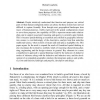Free Online Productivity Tools
i2Speak
i2Symbol
i2OCR
iTex2Img
iWeb2Print
iWeb2Shot
i2Type
iPdf2Split
iPdf2Merge
i2Bopomofo
i2Arabic
i2Style
i2Image
i2PDF
iLatex2Rtf
Sci2ools
COSIT
2009
Springer
2009
Springer
The Abduction of Geographic Information Science: Transporting Spatial Reasoning to the Realm of Purpose and Design
People intuitively understand that function and purpose are critical parts of what human-configured entities are about, but these notions have proved difficult to capture formally. Even though most geographical landscapes bear traces of human purposes, visibly expressed in the spatial configurations meant to serve these purposes, the capability of GIS to represent means-ends relationships and to support associated reasoning and queries is currently quite limited. This is because spatial thinking as examined and codified in geographic information science is overwhelmingly of the descriptive, analytic kind that underlies traditional science, where notions of means and ends play a negligible role. This paper argues for the need to expand the reach of formalized spatial thinking to also encompass the normative, synthetic kinds of reasoning characterizing planning, engineering and the design sciences in general. Key elements in a more comprehensive approach to spatial thinking would be the ...
| Added | 17 Feb 2011 |
| Updated | 17 Feb 2011 |
| Type | Journal |
| Year | 2009 |
| Where | COSIT |
| Authors | Helen Couclelis |
Comments (0)

